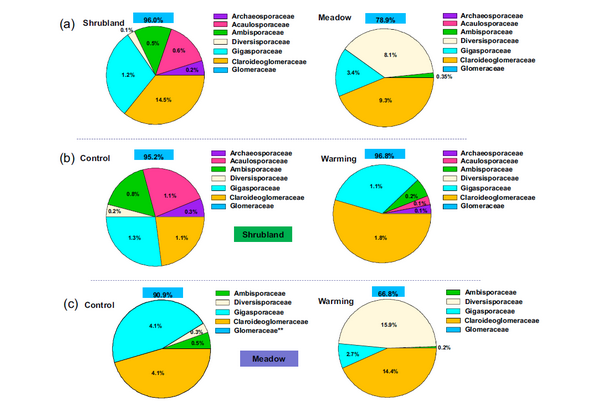Arbuscular mycorrhizal fungi (AMF) are widespread root-associated microorganisms that participate in many ecosystem processes. However, the response of AMF communities to global warming still remains poorly understood, especially in high-altitude regions. This study investigated the responses of AMF communities to 17- year experimental warming with open top chambers in two habitat types (i.e., shrubland and meadow) of the alpine meadow ecosystem of the Qinghai–Tibet Plateau. For this, 454-pyrosequencing was used and the main ecological processes that structure AMF communities were inferred based on distributions of species abundance and phylogenetic patterns. A total of 110 different AMF phylotypes (shrubland habitat: 102; meadow habitat: 91) were identified in both habitats, predominantly belonging to Glomeraceae. Eighty AMF phylotypes were found in both habitats, and phylotypes affiliated with Acaulosporaceae and Archaeosporaceae were only found in the shrubland habitat. Warming did not affect AMF diversity or community composition in the shrubland habitat; however, in the meadow habitat, warming caused a decline of AMF species richness by 45.6%. Moreover, the taxon composition of AMF communities was changed via the negative influence of root biomass in the meadow habitat. Mandelbrot, based on the niche process, was the best-fitting model for all fungal data sets in both habitats, indicating that fungal community dynamics under warming treatments matched niche-based processes in both habitats. Moreover, the phylogenetic structure of AMF communities was always phylogenetically clustered regardless of warming in the shrubland habitat. However, the phylogenetic structure changed from phylogenetic clustering of the control treatment to random of warming treatment in the meadow habitat. This suggests that in the shrubland habitat, warming does not change the central ecological process that structures AMF communities, but rather, leads to the transformation of the central process from environmental filtration to the neutralization of habitat filtration and competition exclusion in the meadow habitat. In summary, these results indicate that the effect of long-term warming on the assemblage of AMF communities depends on the habitat type. This illustrates that maintaining a high habitat type complexity is conducive for the response of alpine meadow ecosystems to climate warming.

Fig. 3. Proportion of relative abundance of phylotypes grouped by the AMF family in different treatments. Based on paired t-tests, families that were significantly more abundant in particular habitats are indicated by asterisks (*P < 0.05; **P < 0.01).
This result was published in Applied Soil Ecology with the title of “The effects of long-term warming on arbuscular mycorrhizal fungal communities depend on habitat type on the Qinghai-Tibet Plateau”
The link below will guide you to the reading:
